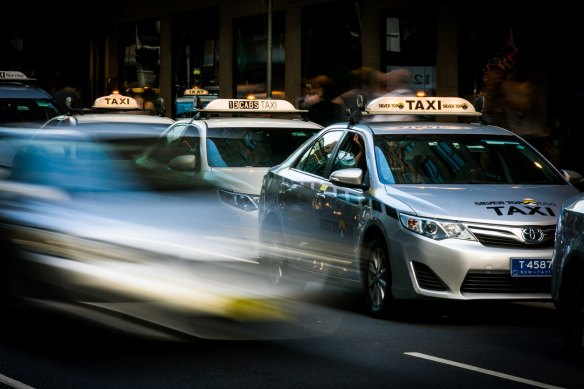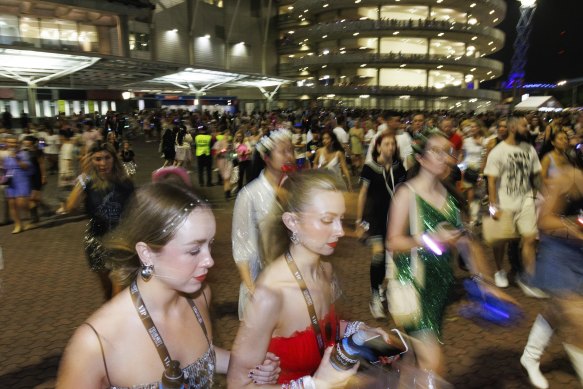This was published 8 months ago
Opinion
Fare’s fair? How a Swiftie surge turned a taxi rank into The Hunger Games
Anthony Segaert
ReporterYou’ve got to hand it to them: whoever planned the train exodus out of Sydney Olympic Park after Friday night’s first Taylor Swift concert is a mastermind. Living up to what was promised, the trains departed every five minutes, and the vast majority of the 81,000 Swifties present made it out of the venue within an hour of the final song.
After the chaos that engulfed the city last time we held a major event, it’s a feat worth applauding. Sydney’s transport network had the chance to shine with 300,000 bejewelled journeys, and it did. It’s just a shame taxi drivers didn’t get the message.

Sydney taxis must use their meters to set the fares – every time, without exception.Credit: Anna Kucera
After arriving at Central Station on one of the last trains back at 1am, having reported on the concert from outside the stadium, all the bus services I’d normally catch home had ended for the evening, effectively forcing me to take a cab or Uber.
And as I ventured off the Grand Concourse, I witnessed what could only be described as Swift-induced chaos. Hundreds of people were attempting to get a cab home with no marshalling or management, and that made it prime fodder for a good old-fashioned taxi rip off.
My suspicion was first raised when a woman and her elderly mother were turned away from one cab. Before I could tell him my destination, that driver defended himself: “They were only going 500 metres!“
So I wasn’t surprised when he demanded $50 for my 15-minute trip home. When I requested to pay what the meter said at the end of our trip, he, with masterful choreography that wouldn’t be out of place at the concert, raised his middle finger and drove off.
The same thing happened with the next cab I approached, except he also wanted it upfront in cash (a driver is allowed to request payment ahead of the trip if they’re concerned you aren’t able to pay, but this price was clearly a rort).
It was at that point, when I thought things couldn’t get much classier, that another driver, in some fit of rage, had got out of his car, marched up to the driver in front of him and began aggressively filming him through the window and over the bonnet of his car, only for that driver to begin lurching forward, beginning to run him over.
In NSW, taxis are considered an extension of the public transport network. The industry talks about its role in providing “first and last mile” trips, like mine on Friday night, that connect people to major transport hubs.
So because the government relies on the industry to get people home, it has laws in place to ensure cabs work to serve the public: a driver, for example, cannot refuse a trip based on the length of a trip (though they can if they are at the end of their shift, if a passenger can’t prove that they can pay, or a passenger is drunk or disorderly).

Taylor Swift fans on their way home from Accor Stadium.Credit: Max Mason-Hubers
And because they’re a public service, in the same way that a bus or a train is, taxis must use their meters to set the fares, every time, without exception.
But in NSW, where about 6500 people have licences to drive taxis, it appears more and more are doing the opposite – illegally charging exorbitant fares and flouting all regulations that attempt to crack down on the practice. There were more than 1000 complaints about price gouging, meter usage and trip refusals in just seven months, according to data obtained by The Guardian.
The reality is that passengers – despite knowing the rules and arguing about the meter – aren’t the ones with the upper hand. We face a choice between getting home or waiting in the middle of the night for another cab to appear.
The Point-to-Point Commissioner, the statutory office responsible for regulating the taxi and ride-share industry, was set up to improve this situation. One of Commissioner Anthony Wing’s key measures has been the implementation of the Taxi Fare Hotline, where passengers can report being taken for a ride.
He specifically warned drivers ahead of the suspected Swift-surge that his officers would be out in force cracking down on illegal fare rorting.
Apart from Sam, the courteous cabbie who put the meter on as soon as we drove off, it appears most drivers that night heard the warning and decided to shake it off.
Anthony Segaert is a reporter covering urban affairs at the Sydney Morning Herald.
Get a weekly wrap of views that will challenge, champion and inform your own. Sign up for our Opinion newsletter.